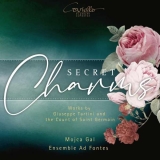Dass gerade auch Geiger mitunter nur als technisch überwältigende Spieler wahrgenommen werden, die musikalische Aussage aber vermisst wird, ist nicht nur heute so. Bereits im 18. Jahrhundert soll Tartini einen anderen Geiger so charakterisiert haben. Tartini selber dagegen soll nachgesagt worden sein, dass er die Geige singe und nicht spiele. Da darf man sowohl den technisch versierten als auch interpretatorisch reifen Spieler annehmen. Ähnlich wurde über den Grafen St. Germain gesprochen. Dabei war es diesen Geigern nur möglich, einen persönlichen Stil zu zeigen, wenn sie das aufgeschrieben Notengerüst mit ihren, üblicherweise improvisierten und situationsbezogenen Verzierungsmöglichkeiten, und deren gab es viele, ausschmückten. Und alle diese Ausschmückungen dienten dazu, die menschliche Stimme und damit auch die Eigenarten der Sänger instrumental umzusetzen.
Mojca Gal und das Ensemble Ad Fontes haben für ihre CD Werke dieser beiden Komponisten ausgewählt. Dabei gesteht man der Geigerin gerne zu, dass sie die Idee ausgeschmückter Präsentation beherzigt und hörbar macht. Es mag zunächst der Eindruck entstehen, dass sie zurückgenommen agiert und jegliche Form eines virtuosen Habitus vermeidet, so dass man im Ansatz eine zu eintönige Darbietung befürchten mag. Aber diese wenig zur Schau stellende Linie entpuppt sich dann als die große Stärke. Denn die Interpretationen bleiben durchgehend spannend und intensiv, aber werden eben nie äußerlich und plakativ. Vielmehr erobert Gal eine darstellerisch affektierte Tiefe, wie die Musik zur Zeit der beiden Komponisten das wollte.
Das Ensemble Ad Fontes trägt dazu mit einer nuancierten und kolorierenden Begleitung stützend bei. In der Sonate für zwei Violinen übernimmt Anne Simone Aeberhard mit der Blockflöte die zweite Melodiestimme, was man im Beiheft nicht lesen, aber eben hören kann.
The fact that violinists in particular are sometimes perceived only as technically overwhelming players, while the musical statement is missed, is not only the case today. As early as the 18th century, Tartini is said to have characterized another violinist in this way. Tartini himself, on the other hand, is said to have sung the violin and not played it. In this case, one may assume both the technically accomplished and the interpretatively mature player. Similar things were said about Count St. Germain. It was only possible for these violinists to show a personal style if they embellished the written score with their, usually improvised and situation-related, ornamentation possibilities, and there were many of them. And all these embellishments served to instrumentally realize the human voice and thus also the singers’ idiosyncrasies.
Mojca Gal and the Ensemble Ad Fontes have selected works by these two composers for their CD. One readily concedes that the violinist takes the idea of embellished presentation to heart and makes it audible. At first, one might get the impression that she acts in a restrained manner and avoids any form of virtuoso habitus, so that one might fear a too monotonous performance. But this little showy line then turns out to be the great strength. For the interpretations remain exciting and intense throughout, but never become external and striking. Rather, Gal conquers an actorically affected depth, as the music at the time of the two composers wanted.
The Ensemble Ad Fontes adds to this with a nuanced and colorful accompaniment. In the Sonata for two violins Anne Simone Aeberhard takes over the second melody part with the recorder, which cannot be read in the booklet, but can be heard.
























